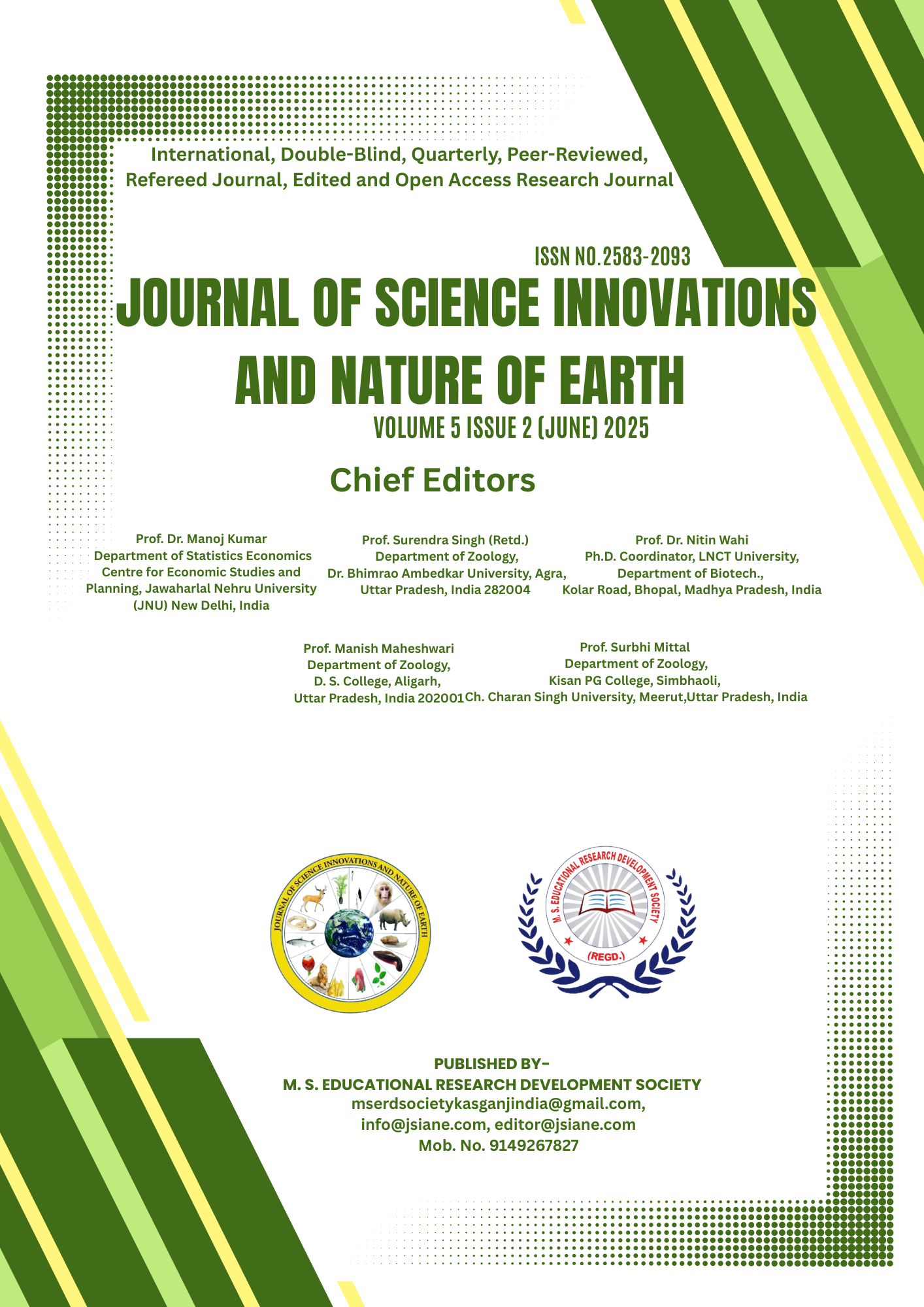Comparative Study of Heavy Metal Toxicity on Chlorophyll and Carotenoid Levels in Vigna radiata L. Seedlings
DOI:
https://doi.org/10.59436/jsiane.337.2583-2093Keywords:
Heavy Metal, Toxicity, Chlorophyll Content, Carotenoid Levels, Vigna radiata L., Seedling GrowthAbstract
Rapid industrialization and urbanization have resulted in the contamination of natural resources, particularly water bodies and agricultural soils. This pollution has severely disrupted ecological balance and agricultural productivity, posing a serious threat to global food security. Among the various pollutants, heavy metals such as cadmium (Cd), lead (Pb), and nickel (Ni) are of particular concern due to their high toxicity, persistence in the environment, and tendency to accumulate in plant tissues. This study examines the effects of these heavy metals on the photosynthetic pigments of Vigna radiata L. (mung bean) seedlings, a nutritionally important legume crop. Seedlings were exposed to different concentrations of Cd, Pb, and Ni, and their total chlorophyll and carotenoid contents were measured. The results showed that all three heavy metals significantly reduced pigment levels, with the degree of reduction increasing alongside concentration. At 1000 ppm, cadmium caused the greatest decline in both chlorophyll and carotenoid levels, followed by lead and then nickel, establishing a toxicity order of Cd > Pb > Ni. The substantial decrease in photosynthetic pigments indicates impaired photosynthetic activity, leading to reduced plant growth and productivity. These findings underscore the urgent need for effective monitoring and management of heavy metal pollution to safeguard agricultural systems and promote sustainable food production.
References
Arvind, P.and M.N.V. Prasad. 2004: Zinc protects chloroplasts and associated photochemical functions in cadmimum exposed Ceratophyllum demersum L., a fresh water macrophyte. Plant Science 166:1-15
Arnon, D.I. 1949: Copper enzyme in isolated chloroplasts. Polyphenoloxidase in Beta vulgaris. Plant Physiology. 24:1-15.
Dube, B.K., P. Sinha and C. Chatterjee, 2002: Changes in spinach (Spinacea oleracea L.) metabolites by excess cadmium. Nature Environment & Pollution Technology. 1:225-229.
Gautam, M., R.S. Senger, S.K. Garg, K. Senger and R. Choudhary.2008: Effect oflead on seed germination ,seedling growth, chlorophyll content and nitrate reductase activity in Mungbean (Vigna radiata) .Reseach Journal of Phytochemistry,2:61-68.
Jain,U.and Bhansali.2008a: Efeect of certain heavy metals on pigment contents of seedling of Cyamopsis tetragonoloba(L) taub.cv RGC 936.journal of Phytological research,21: 127-130.
Jain,U.and Bhansali.2008b: Efeect of certain heavy metals on pigment contents of seedling of Cyamopsis tetragonoloba(L) taub.cv RGC 1002. Indian .journal of Environmental Science.12: 129-132.
Kirk, J.T.O. and R.L. Allen 1965: Dependence of chloroplast pigment synthases on their protein synthesis.Effect of actidion. Biochemistry Research Community 21:523-530.
Krishnamurti, C.R. 1985: Enironment, Chemicals and Man. Madras Science Foundation .138.
Kumar, S.1999: Effect of some heavy metals on biochemical changes in excised leaves of Catharanthus roseus (L.) g.Don.Advances in Plant Science 12:183-190.
Kupper,H,F. Kupper and S. Miller. 1996: Environmental relevance of heavy metal substituted chlorophyll using the example of water plants. Journal of Experimental Botany47:259-266.
Mishra, R. 1968: Ecology Work Book of Oxford and IBH Publishing Co. New Delhi, Bombay, Calcutta. Pp 1-226.
Prasad, S.M., R. Dwivedi, M. Zeesham and R.Singh,:2004UV-B and Cd-induced changes in pigments, photosynthetic electron transport activity antioxidant levels and antioxidative enzymes activity of Ricci asp. Acta Physiology of Plant. 26:423-430.
Sagardoy, R.F. morales,A.F.Lobez-Millan,A. and J.abadia. 2008: Effect of zinc toxicity on sugerbeet (Beeta vulgarisL.) plants grown in hydroponics. Pt.Biol. (German society) Royal Botanical Society of Netheroands 1435-8603.
Siedilecka, A.A. Tukiendorf, P.E. Skorzynska, M. Maksymiec, T. Bazynski and Z. krupa. 2001: Selected angiosperm families response to heavy metals on the environmentIn; M.N.V. Prasad (Ed.) Metals in the environmental: analysis by Biodiversity, marcel dekkar Inc.171-218.
Sinha, S., S Mukherji and J.Dutta .202: Effect of manganese toxicity on pigment content, Hill activity and photosynthetic rate of vigna radiate (L.) Wilczek seedlings. Journal of Environmental Biology 23:253-257.
Kacholia, Suman and Manisha Chauhan 2018. The effect of certain heavy metals on total cholorophyll and carotenoids content of cyamopsis tetragonoloba cvs 936 and 1002, international journal of current pharmaceutical review and research; 10(1); 45-50
Symeonidia,L and S.Karataglis. 2008 : The effect of lead and zinc on plant growth and chlorophyll content of Holchus lanalusL. Journal of agronomy and Crop science 168:108-112.
Wood,j. H.J, Segall,W.P.Bideley,A. chen, W. Chudyk and J.S. Thayer.1975: Procedding of International Conference on heavy metals in the environment. Toronto, Ontario,Canada.40:68. Varsha Tiwari, Beena Sharma, Amit Dubey 2018, "Phyto-Toxic Effects of Various Concentrations of Cu and Pb on the Seed Germination and Seedling Survival of V. Radiata". International Journal of Trend in Research and Development (IJTRD), , Vol.-5 | Issue-4,
Shouric, A., 2022: Effect of cadmium and lead stress on seed germination and seedling growth of Jatropha curcasL. Bio. Sci. Biotech. Res. Asia. 19(3).
Ning, Wang, haochen and Yaoou, Tain 2024: Effect of Nikel, Lead, and Copper stress on the growth and biochemical responces of Aegilops terchii seedling. Nature 14(24832).
Divyashree, D. and G. Lavaniya.2023: Effect of heavy metals ( Nickel and lead) on plant growth , Protein, Proline, Chlorophyll and Phenol content on sugercane saccharum plants att In-vivo condition.international journal of Advance Research in Science, communication and technologyVol. 3(2). 292-301

Downloads
Published
Issue
Section
License
Copyright (c) 2025 Maharaj Singh Educational Research Development Society

This work is licensed under a Creative Commons Attribution-NonCommercial 4.0 International License.









